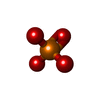+Search query
-Structure paper
| Title | Exploiting activation and inactivation mechanisms in type I-C CRISPR-Cas3 for genome-editing applications. |
|---|---|
| Journal, issue, pages | Mol Cell, Vol. 84, Issue 3, Page 463-475.e5, Year 2024 |
| Publish date | Feb 1, 2024 |
 Authors Authors | Chunyi Hu / Mason T Myers / Xufei Zhou / Zhonggang Hou / Macy L Lozen / Ki Hyun Nam / Yan Zhang / Ailong Ke /    |
| PubMed Abstract | Type I CRISPR-Cas systems utilize the RNA-guided Cascade complex to identify matching DNA targets and the nuclease-helicase Cas3 to degrade them. Among the seven subtypes, type I-C is compact in size ...Type I CRISPR-Cas systems utilize the RNA-guided Cascade complex to identify matching DNA targets and the nuclease-helicase Cas3 to degrade them. Among the seven subtypes, type I-C is compact in size and highly active in creating large-sized genome deletions in human cells. Here, we use four cryoelectron microscopy snapshots to define its RNA-guided DNA binding and cleavage mechanisms in high resolution. The non-target DNA strand (NTS) is accommodated by I-C Cascade in a continuous binding groove along the juxtaposed Cas11 subunits. Binding of Cas3 further traps a flexible bulge in NTS, enabling NTS nicking. We identified two anti-CRISPR proteins AcrIC8 and AcrIC9 that strongly inhibit Neisseria lactamica I-C function. Structural analysis showed that AcrIC8 inhibits PAM recognition through allosteric inhibition, whereas AcrIC9 achieves so through direct competition. Both Acrs potently inhibit I-C-mediated genome editing and transcriptional modulation in human cells, providing the first off-switches for type I CRISPR eukaryotic genome engineering. |
 External links External links |  Mol Cell / Mol Cell /  PubMed:38242128 / PubMed:38242128 /  PubMed Central PubMed Central |
| Methods | EM (single particle) |
| Resolution | 3.0 - 3.64 Å |
| Structure data | EMDB-29877, PDB-8g9s: EMDB-29878, PDB-8g9t: EMDB-29879, PDB-8g9u: EMDB-29896, PDB-8gaf: EMDB-29900, PDB-8gam: EMDB-29901, PDB-8gan: |
| Chemicals |  ChemComp-MG:  ChemComp-PO4: |
| Source |
|
 Keywords Keywords | HYDROLASE/RNA / CRISPR / type I-C / cascade / anti-CRISPR / HYDROLASE-RNA complex / DNA BINDING PROTEIN / HYDROLASE/RNA/DNA / HYDROLASE-RNA-DNA complex |
 Movie
Movie Controller
Controller Structure viewers
Structure viewers About Yorodumi Papers
About Yorodumi Papers















 neisseria lactamica (bacteria)
neisseria lactamica (bacteria) rhodobacter phage rcnl1 (virus)
rhodobacter phage rcnl1 (virus)